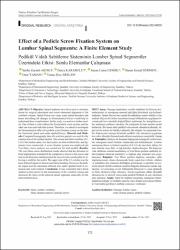| dc.contributor.author | Karabulut, Derya | |
| dc.contributor.author | Doğru, Suzan Cansel | |
| dc.contributor.author | Sürmen, Hasan Kemal | |
| dc.contributor.author | Yaman, Onur | |
| dc.contributor.author | Arslan, Yunus Ziya | |
| dc.date.accessioned | 2024-04-04T13:44:43Z | |
| dc.date.available | 2024-04-04T13:44:43Z | |
| dc.date.issued | 2023 | en_US |
| dc.identifier.citation | Karabulut, D., Doğru, Suzan C., Sürmen, Hasan K., Yaman, O., Arslan, Yunus Z. (2023). Effect of a pedicle screw fixation system on lumbar spinal segments: A finite element study. Türkiye Klinikleri Tıp Bilimleri Dergisi içerisinde 43 (4), 372-381. | en_US |
| dc.identifier.uri | https://hdl.handle.net/20.500.12846/1001 | |
| dc.description.abstract | Spinal implants have been used to stimulate
fusion by surgical adjustment and correct abnormal alignment of the
vertebral column. Spinal fusion can cause some spinal disorders and
hence describing the changes in biomechanical forces would help to
understand these complications. In this study, we used two lumbar models. One of them is used without the fixed pedicle screw system, and the
other one was used with that system. Therefore, we aimed to investigate
the biomechanical effect of a pedicle screw fixation system on the lumbar functional spinal unit under applied forces. Material and Methods: Computed tomography data of a scoliotic patient was used for the
construction of the lumbar models. The second and third vertebrae (L2-
L3) of the lumbar spine, two facet joints, an intervertebral disc, and ligaments were constructed. A screw fixation system was employed and
Von-Mises stress analysis was carried out for both models. Results:
The von Mises stress distribution results showed that the presence of
fixed implantation transmitted the compressive forces to the screws and
rods in all directions and decreased the stress levels considerably by allowing to stabilize the model. The upper side of the L2 vertebra was the
most affected region in flexion and lateral bending. However, the pedicle region had the maximum affected area under applied loads in extension and axial rotation. Conclusion: It was concluded that a fixed
implant system preserves the maintenance of the vertebral column and
decreases the stress on the adjacent spinal segments, especially for the
intervertebral discs. | en_US |
| dc.description.abstract | Omurga implantları, cerrahi müdahale ile füzyonu hızlandırmaları ve omurganın anormal eğriliğini düzeltmek için kullanılmaktadır. Spinal füzyon bazı spinal bozukluklara neden olabilir ve bu
nedenle füzyon ile lomber omurların komşu bölümlerine uygulanan biyomekanik kuvvetlerdeki değişiklikleri açıklamak, bu komplikasyonları anlamaya yardımcı olacaktır. Bu çalışmada iki tane lomber model
kullanıldı. Bir tanesi sabit pedikül vida sistemi olmadan kullanıldı, diğeri ise bu sistem ile birlikte kullanıldı. Bu sebeple, bu çalışmada lomber fonksiyonel omurga biriminde pedikül vida sisteminin uygulanan
kuvvetler altındaki biyomekanik etkisini araştırmayı amaçladık. Gereç
ve Yöntemler: Skolyoz bir hastanın bilgisayarlı tomografi verileri lomber omurganın temel birimini oluşturmak için kullanılmıştır. Lomber
omurganın ikinci ve üçüncü omurları (L2-L3), iki tane faset eklem, bir
tane omurlar arası disk ve bağ dokuları oluşturulmuştur. Bir titanyum
vida sabitleme sistemi tasarlanmış ve Von Mises gerilme analizleri intakt (implant olmayan sistemler) ve implant olan sistemler için uygulanmıştır. Bulgular: Von Mises gerilme dağılımı sonuçları, sabit
implantasyonun olması durumunda baskı yapan kuvvetlerin vidalara
ve çubuklara tüm yönlerde iletildiğini göstermiştir ve gerilme seviyelerini önemli ölçüde azaltarak modelin dengede durmasına olanak sağlamıştır. L2 omurunun en üst bölümünün fleksiyon ve yana eğilmede
en fazla etkilenen bölge olmuştur. Ancak uygulanan yükler altındaki
ekstansiyon ve aksiyal rotasyonda pedikül bölümü en çok etkilenen
alan olmuştur. Sonuç: Sabit bir implant sisteminin omurganın bütünlüğünü koruduğu ve özellikle omurlar arası diskler için komşu bölümler üzerindeki gerilmeyi azalttığı sonucuna varılmıştır. | en_US |
| dc.language.iso | eng | en_US |
| dc.relation.isversionof | 10.5336/medsci.2023-99005 | en_US |
| dc.rights | info:eu-repo/semantics/openAccess | en_US |
| dc.subject | Spine | en_US |
| dc.subject | Lumbar vertebrae | en_US |
| dc.subject | Finite element analysis | en_US |
| dc.subject | Pedicle screws | en_US |
| dc.subject | Omurga | en_US |
| dc.subject | Lomber omur | en_US |
| dc.subject | Sonlu eleman analizi | en_US |
| dc.subject | Pedikül vidaları | en_US |
| dc.title | Effect of a pedicle screw fixation system on lumbar spinal segments: A finite element study | en_US |
| dc.title.alternative | Pedikül vidalı sabitleme sisteminin lomber spinal segmentler üzerindeki etkisi: Sonlu elemanlar çalışması | en_US |
| dc.type | article | en_US |
| dc.relation.journal | Türkiye Klinikleri Tıp Bilimleri Dergisi | en_US |
| dc.identifier.volume | 43 | en_US |
| dc.identifier.issue | 4 | en_US |
| dc.relation.publicationcategory | Makale - Uluslararası Hakemli Dergi - Kurum Öğretim Elemanı | en_US |
| dc.contributor.department | TAÜ, Fen Bilimleri Enstitüsü, Robotlar ve Akıllı Sistemler Ana Bilim Dalı Koleksiyonu | en_US |
| dc.identifier.startpage | 372 | en_US |
| dc.identifier.endpage | 381 | en_US |

















